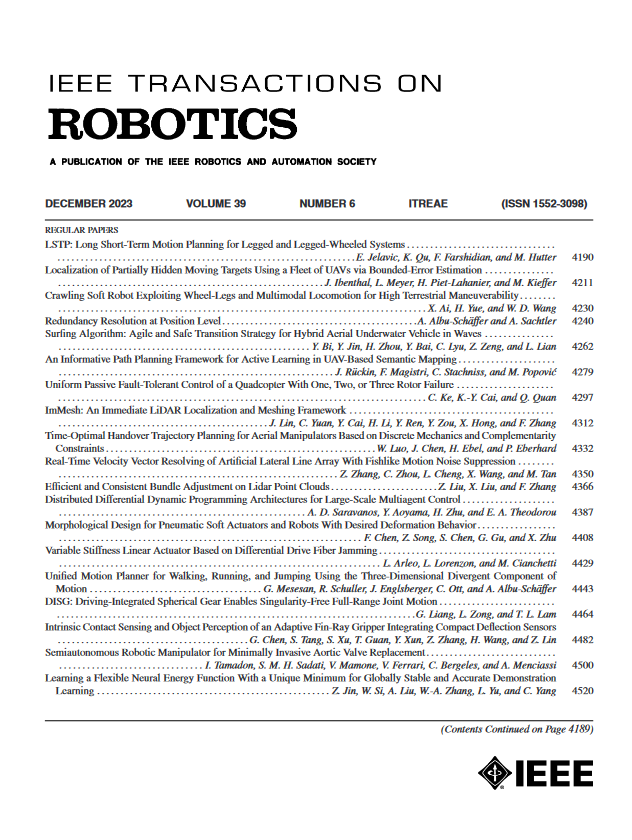BotVIO:一种基于轻型变压器的机器人视觉惯性里程计
IF 10.5
1区 计算机科学
Q1 ROBOTICS
引用次数: 0
摘要
视觉惯性里程计(VIO)为同时定位和映射系统提供了一个强大的定位解决方案。自我监督的VIO是一种领先的方法,它的优点是不需要大量的事实基础标签。遗憾的是,由于模型设计不足导致计算复杂性,这种方法在机器人应用中仍然面临挑战,特别是无人飞行器。为了解决这一瓶颈,我们引入了BotVIO(其中“Bot”指的是“机器人”),这是一种基于变压器的自监督VIO模型,为减轻机器人的计算负担提供了一个很好的解决方案。我们的轻量级骨干结合了浅cnn和时空增强变压器来取代传统的架构,而极简交叉融合模块使用单层交叉关注来增强多模态交互。大量实验表明,在姿态估计过程中,BotVIO实现了显著的可训练参数减少70.37%,推理速度降低74.85%,在NVIDIA Jetson NX (10W&2CORE)上达到57.80 fps,同时提高了姿态精度和鲁棒性。为了社区的利益,我们公开了源代码本文章由计算机程序翻译,如有差异,请以英文原文为准。
BotVIO: A Lightweight Transformer-Based Visual–Inertial Odometry for Robotics
Visual–inertial odometry (VIO) provides a robust localization solution for simultaneous localization and mapping systems. Self-supervised VIO, a leading approach, has the advantage of not requiring extensive ground-truth labels. Regrettably, this method still poses challenges for robotic applications, particularly uncrewed aerial vehicles, due to its computational complexity arising from inadequate model designs. To address this bottleneck, we introduce BotVIO (where “Bot” refers to “robotics”), a transformer-based self-supervised VIO model, offering an excellent solution to alleviate computational burdens for robotics. Our lightweight backbone combines shallow CNNs with spatial–temporal-enhanced transformers to replace conventional architectures, while the minimalist cross-fusion module uses single-layer cross-attention to enhance multimodal interaction. Extensive experiments show that, during pose estimation, BotVIO achieves a remarkable 70.37% reduction in trainable parameters and a 74.85% decrease in inference speed, reaching up to 57.80 fps on an NVIDIA Jetson NX (10W&2CORE), while improving pose accuracy and robustness. For the benefit of the community, we make public the source code.1
求助全文
通过发布文献求助,成功后即可免费获取论文全文。
去求助
来源期刊

IEEE Transactions on Robotics
工程技术-机器人学
CiteScore
14.90
自引率
5.10%
发文量
259
审稿时长
6.0 months
期刊介绍:
The IEEE Transactions on Robotics (T-RO) is dedicated to publishing fundamental papers covering all facets of robotics, drawing on interdisciplinary approaches from computer science, control systems, electrical engineering, mathematics, mechanical engineering, and beyond. From industrial applications to service and personal assistants, surgical operations to space, underwater, and remote exploration, robots and intelligent machines play pivotal roles across various domains, including entertainment, safety, search and rescue, military applications, agriculture, and intelligent vehicles.
Special emphasis is placed on intelligent machines and systems designed for unstructured environments, where a significant portion of the environment remains unknown and beyond direct sensing or control.
 求助内容:
求助内容: 应助结果提醒方式:
应助结果提醒方式:


